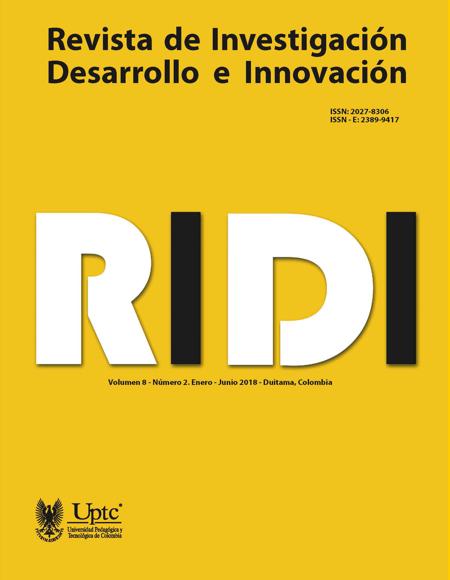Validación del modelo matemático de un panel solar empleando la herramienta Simulink de Matlab

Resumen
El objetivo de este trabajo es realizar un análisis estadístico y una validación de los resultados obtenidos de las simulaciones de un panel solar, con la herramienta Matlab/Simulink. Se realizaron una serie de mediciones de la potencia generada por el panel solar, bajo diferentes condiciones de radiación y temperatura de operación; luego se simuló el comportamiento del panel mediante el modelo matemático y el modelo del mismo establecido por Simulink; por último, se realizó un análisis de la aproximación de cada una de las simulaciones con los datos reales. Los resultados indican que, para la simulación por medio del modelo matemático del panel solar, se obtuvo un coeficiente de determinación de 0.9889, mientras que, para el modelo del panel solar establecido por Simulink fue de 0,8673. Lo anterior evidencia la buena correlación de cada una de las simulaciones realizadas con los valores reales, llegando a la conclusión que, aunque los dos métodos utilizados se acercan a la realidad, el modelo matemático del panel solar consigue una mejor aproximación.Palabras clave
coeficiente de determinación, modelo matemático, panel solar, Matlab
Biografía del autor/a
Anderson Guillermo Vera-Dávila
Estudiante Ingeniería Electrónica
Jhan Carlos Delgado-Ariza
Estudiante Ingeniería Electrónica
Sergio Basilio Sepúlveda-Mora
Ingeniero electrónico, Magíster en Ingeniería Eléctrica y Computación
Citas
- Acevedo-Luna, A., & Morales-Acevedo, A. (2018). Study of validity of the single-diode model for solar cells by I–V curves parameters extraction using a simple numerical method. Journal of Materials Science: Materials in Electronics, 1–7. doi: http://doi.org/10.1007/s10854-018-8793-x DOI: https://doi.org/10.1007/s10854-018-8793-x
- Agency, I. I. E. (2016). Tracking Clean Energy Progress 2016. Recuperado de: www.iea.org/etp/tracking for
- Altas, I. H., & Sharaf, A. M. (2007). A Photovoltaic Array Simulation Model for Matlab-Simulink GUI Environment. In International Conference on Clean Electrical Power, 341–345. Capri, Italy: IEEE. DOI: https://doi.org/10.1109/ICCEP.2007.384234
- De Soto, W., Klein, S. A., & Beckman, W. A. (2006). Improvement and validation of a model for photovoltaic array performance. Solar Energy, 80 (1), 78–88. doi: http://doi.org/10.1016/j.solener.2005.06.010 DOI: https://doi.org/10.1016/j.solener.2005.06.010
- González-Longatt, F. (2005). Model of photovoltaic module in Matlab. In Ii Cibelec, (2006), 1–5. Recuperado: http://www.academia.edu/875827/Model_of_Photovoltaic_Module_in_Matlab
- Granda-Gutiérrez, E. E., Orta-Salomón, O. A., Díaz-Guillén, J. C., Jimenez, M. A., Osorio, M., & González, M. A. (2013). Modelado y Simulacion de Celdas y Paneles Solares. Congreso Internacional de Ingeniería Electrónica 2013. 17–22. doi: http://doi.org/10.13140/2.1.4192.8968
- Icaza-Alvarez, D., Calle-Castro, C. J., Córdova-González, F., Lojano-Uguña, A., & Toledo-Toledo, J. F. (2017). Modeling and Simulation of a hybrid system Solar panel and wind turbine in the locality of Molleturo in Ecuador. In 6th International Conference on Renewable Energy Research and Applications (5), 620–625. San Diego: IEEE. doi: http://doi.org/10.1109/DISTRA.2017.8191134 DOI: https://doi.org/10.1109/ICRERA.2017.8191134
- Ideam. (2017). Atlas de Radiación Solar. Recuperado de: http://atlas.ideam.gov.co/basefiles/RadiacionPDF/Cucuta.pdf
- Jimenez, F., & Solé, D. B. (2009). Estudio y simulación de sistemas de conversión fotovoltaica-eléctrica mediante Matlab/Simulink. Saaei’09.
- Kapoor, D., Sodhi, P., & Deb, D. (2012). Solar panel simulation using adaptive control. In International Conference on Control Applications, 1124–1130. Dubrovnik, Croatia. doi: http://doi.org/10.1109/CCA.2012.6402674 DOI: https://doi.org/10.1109/CCA.2012.6402674
- Marín, C. E. (2004). La Energía Solar Fotovoltaica En España. Ninbus, 13–14, 5–31.
- MathWorks. (2017a). Evaluating Goodness of Fit. Recuperado de: https://www.mathworks.com/help/curvefit/evaluating-goodness-of-fit.html
- MathWorks. (2017b). PV Array. Recuperado de: https://www.mathworks.com/help/physmod/sps/powersys/ref/pvarray.html
- Navidi, W. (2006). Estadística para ingenieros y científicos. México: M.-H. Interamericana, Ediciones.
- Nguyen, X. H., & Nguyen, M. P. (2015). Mathematical modeling of photovoltaic cell/module/arrays with tags in Matlab/Simulink. Environmental Systems Research, 4 (1), 24. doi: http://doi.org/10.1186/s40068-015-0047-9 DOI: https://doi.org/10.1186/s40068-015-0047-9
- Reyes-Caballero, F., Fernández-Morales, F., & Duarte, J. (2016). Panorama energético. Revista de Investigación, Desarrollo e Innovación, 7 (1), 151-163. doi:http://dx.doi.org/10.19053/20278306.v7.n1.2016.5605 DOI: https://doi.org/10.19053/20278306.v7.n1.2016.5605
- Rezk, H., & Hasaneen, E. S. (2015). A new MATLAB/Simulink model of triple-junction solar cell and MPPT based on artificial neural networks for photovoltaic energy systems. Ain Shams Engineering Journal, 6 (3), 873–881. doi: http://doi.org/10.1016/j.asej.2015.03.001 DOI: https://doi.org/10.1016/j.asej.2015.03.001
- Salmi, T., Bouzguenda, M., Gastli, A., & Masmoudi, A. (2012). MATLAB / Simulink Based Modelling of Solar Photovoltaic Cell. International Journal of Renewable Energy Research, 2(2), 213–218. doi: http://doi.org/10.1234/IJRER.V2I2.157
- Selmi, T., & Belghouthi, R. (2017). A novel widespread Matlab/Simulink based modeling of InGaN double hetero-junction p-i-n solar cell. International Journal of Energy and Environmental Engineering, 8 (4), 273–281. doi: http://doi.org/10.1007/s40095-017-0243-7 DOI: https://doi.org/10.1007/s40095-017-0243-7
- Setiawan, E. A., Setiawan, A., & Siregar, D. (2017). Analysis on solar panel performance and PV-inverter configuration for tropical region. Journal of Thermal Engineering, 3 (3), 1259–1270. doi: http://doi.org/10.18186/journal-of-thermal-engineering.323392 DOI: https://doi.org/10.18186/journal-of-thermal-engineering.323392
- Silvestre, S., Castañar, L., & Guasch, D. (2008). Herramientas de Simulación para Sistemas Fotovoltaicos en Ingeniería. Formación Universitaria, 1 (1), 13–18. doi: http://doi.org/10.4067/S0718-50062008000100003 DOI: https://doi.org/10.4067/S0718-50062008000100003
- Smets, A., Jäger, K., Isabella, O., Van Swaaij, R., & Zeman, M. (2016). Solar Energy: The Physics and Engineering of Photovoltaic Conversion, Technologies and Systems. UK: Uit Cambridge.
- Tsai, H., Tu, C., & Su, Y. (2008). Development of Generalized Photovoltaic Model Using MATLAB / SIMULINK. In Proceedings of the World Congress on Engineering and Computer Science 2008 WCECS 2008, 6. San Francisco, USA.
Descargas
Los datos de descargas todavía no están disponibles.